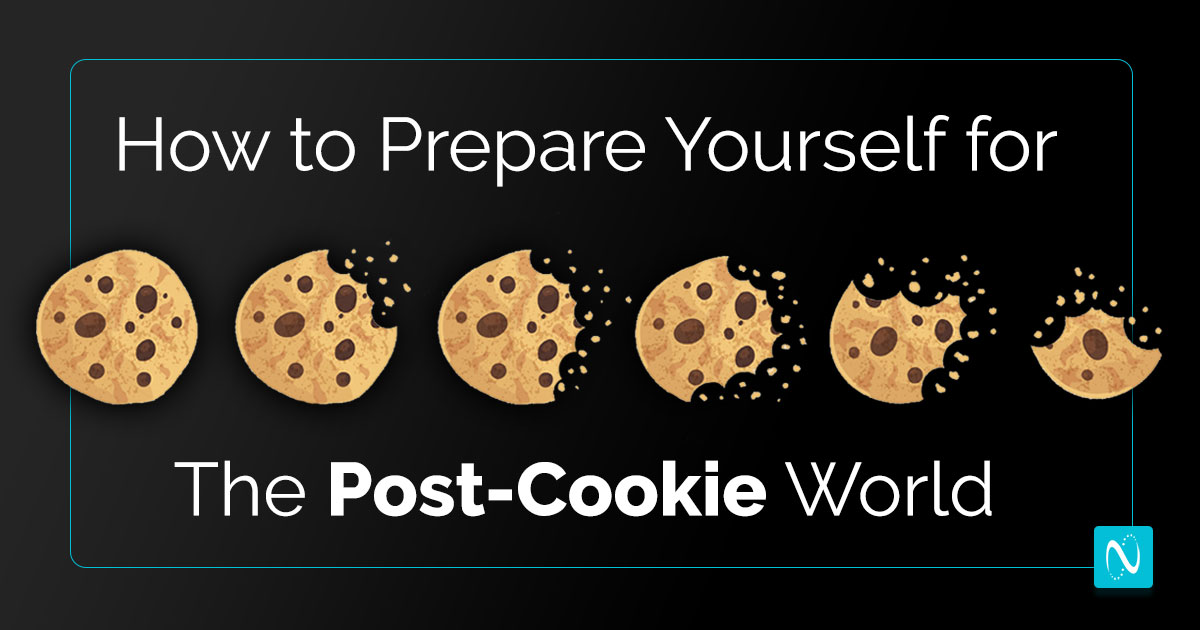“Half the money I spend on advertising is wasted; the trouble is, I don’t know which half.” – John Wanamaker
John Wanamaker was considered to be a marketing guru long before there were marketing gurus. (It would have been a real treat to see him use Twitter.) But Mr. Wanamaker had a great point.
In his time, it was a real struggle to quantify what worked and what didn’t. In the modern age, this seemed solved by third-party cookies, as data snippets revealed users’ online activities, helping marketers target better.
But the rising tide of privacy concerns has changed the game. High-profile privacy scandals and education have made users wary.
With giants like Google planning to shelve cookies, we’re thrust into a new era: The post-cookie world. For brands, it’s adapt or fade away.
In this post, here’s how you can navigate this new reality where user privacy reigns supreme.
What is a post-cookie world?
A post-cookie world refers to a future digital landscape where third-party cookies are phased out.
Cookies are small pieces of text sent to your browser by a website you visit. First-party cookies helped all of us, the users, to experience a website in a much more enjoyable way (by remembering preferences such as our default language or our preference for dark mode). They are one of the essential inventions that made the Internet easier to navigate and explore.
However, not all cookies are the same.
Third-party cookies are among the most important inventions that made the Internet commercially viable by streamlining advertising. Unlike first-party cookies that had more of a user experience purpose in mind, third-party cookies are all about marketing dollars and optimizing advertising campaigns. Understanding and monitoring navigation across websites made determining whom to target and how easier. They are also, however, a powerful way to gather information, monitor and erode the privacy we used to have in the early days of the Internet.
Is a post-cookie world definitely going to happen?
We shared at the top that John Wanamaker stated a century ago that half of all advertising budgets go to waste. Would he say the same thing if he knew about cookies? And about the Internet? Probably not.
(Look on the bright side: At least it’s not more than the 97% of all lead gen spend that’s wasted.)
Over the years, cookies, particularly third-party ones, have raised privacy concerns due to their ability to track users’ activities across different websites. Tech giants like Google have announced plans to phase out third-party cookies in Chrome by the end of the year, moving towards a more privacy-focused model.
This digital privacy dilemma around cookies has become widely relevant and essential for users and organizations. We have more education and content that explains to average users what their data is worth such as The Social Dilemma or the Cambridge Analytica Scandal. As a result, many users and organizations have opted to block third-party cookies, making it once again challenging for marketers to understand digital behavior and optimize advertising budgets across campaigns.
The trend is unstoppable. Privacy matters, and users everywhere are more aware of the power of their data than ever before.
To remain relevant, brands have no choice but to adapt to the next stage of digital advertisement; the cookie-less digital experience.
6 ways a post-cookie world impacts marketing
Your marketing campaigns can still be effective even if you cannot access third-party information about your users and their online behavior.
Marketers can leverage creative strategies to beat their competitors, connect their value propositions with their users, and successfully run advertising digital campaigns.
Privacy-first products become more desirable
People are increasingly opting out of cookies across all types of websites and product innovations.
As an example, we can see how companies such as Apple launched its iOS system that allows users to keep their navigation private and opt out of tracking. In May 2021, it was reported that 96% of Apple users were opting out of in-app tracking. Surprisingly, this figure decreased to nearly 75% just a year later.
Unlike a couple of years back, today, users are aware that their data is essential and that “free” products are platforms where the value comes from the user.
Digital products aligning with this new era of the Internet and privacy will have a better chance of becoming a trusted brand in people’s minds.
Reduce ad personalization
It is time to get back to fundamentals and focus on the jobs our product or service solves to gain relevance.
Let’s say you own an online video editing tool and want to launch ads for two audiences. The first needs your product because hiring an in-house media specialist takes too much time, and the second needs it due to the high volume their internal team can no longer handle. While the reasons behind arriving at your solution might differ, both audiences share a similar job; their time is limited, and they need an app to produce videos.
Using the same ad for both audiences is an elegant solution that intuitively connects your value prop with the pressing job users need to solve. Just because personalization is reduced does not mean quality has to suffer.
More reliance on first-party data
While most marketers know the importance of capturing data and constantly improving user experiences with the product, capturing first-party data is only sometimes a priority for organizations.
Often companies ignore their users, skipping direct feedback and overlooking qualitative methodologies (interviews, focus groups, etc.)
In a cookieless world, gathering as much valuable information as you can about your users can be the main lever that helps you grow.
According to the Pew Research Center, most Americans are somewhat concerned about how much data is collected about them by both companies (79%) and the government (64%). Being transparent about the data you collect, what you use it for, and how it may benefit people that are similar to your current users would allow your brand to stand out as a privacy-first solution.
Note: Be sure to create clear policies regarding the type of data you want to collect from users. Skipping being privacy compliant can massively hurt your company and lead to fines.
Greater emphasis on contextual advertising
Being thoughtful about the type of content a particular website has and creating contextually related ads will become more critical for sales and marketing leaders.
Before, with third-party cookies, you could rely less on contextual advertising because you could teach ad networks which segment to target and the type of ad.
In the cookieless new-normal, prioritizing advertising that contextually relates to the website’s content will likely be more successful.
Returning to the online video editing example, imagine you have an excellent SEO piece about the time you can save using the app instead of hiring an in-house specialist. Instead of leaving the page as exclusively SEO-focused, you can add an advertising campaign highlighting the job to be done of “saving time” on the article which can be highly effective.
Marketing attribution will get more challenging in the short term
Marketing attribution will change dramatically in a world without third-party cookies.
However, marketers and sales leaders must develop a set of contradictory skills to help them navigate this paradigm: relying on statistical models to find patterns and letting go of the need to control and attribute all digital efforts.
- Statistical models that help marketers find patterns, correlations, and causations between channels and tactics to improve advertising spend.
- Letting go of the desire to attribute all marketing efforts to results and being comfortable with qualitative and contextual information will gain more and more relevance without cookies. Not everything can be measured, but there are correlations and causations you can find with the right statistical models.
Shift away from paid channels to owned channels
Paid channels work because you can calculate the return on the investment via new opportunities generated. As long as the cost-per-lead (CPL) works for your organization and helps you accomplish your goals, paid channels are a great way to build a sales pipeline.
When every marketing dollar needs to be as efficient as possible, switching to owned channels is a great idea to help you become more cost-efficient. We must unlearn what we have learned about content marketing in many ways to win the battle, but the long-run payoff is worth it.
And how about a post-cookie world for data analysis?
As mentioned above, a world without cookies makes it more difficult for sales and marketing departments to understand how their marketing dollars impact the sales pipeline.
With less information and access to digital footprints, marketing, and sales departments must think outside the box to measure what works instead of relying on retargeting ads.
Emphasize collecting first-party data
Ensure you have the right data-capturing systems in place to understand digital behavior. The more information you can obtain in an orderly manner that ties to the behavioral habits of your users, the easier you can launch successful marketing campaigns and improve your retention KPIs. Motivate users to opt-in to receive communications across channels, and keep your comms engaging and valuable at all times.
On top of setting up the correct data-capturing systems, push your teams to learn as much as possible from your current users. Use mixed research methods, including quick and focused short surveys and in-depth open-ended conversations, plus everything you can think of in between.
Some of the most insightful ideas to improve your product, marketing, and sales processes are already in your user’s heads. All your organization has to do is find a creative way to capture them.
Leverage less granular data and adopt attribution models
It’s easy to assume that the more granularity we have, the better. However, given that companies will now receive less information regarding their traffic source, there is a massive opportunity to find overlapping patterns.
Adopt marketing mix models (MMM) to improve campaign strategies using comprehensive data sets instead of personal information. Although these models have a lot of room for improvement, they provide valuable insights into the successes and failures of multiple variables. For instance, if you’re allocating the same level of spending across numerous channels, a marketing mix model can help you optimize your campaign by experimenting with the variables.
New models also leverage the power of machine learning and artificial intelligence to improve attribution calculations further. There are several options, and many more created daily, that help marketing and sales teams implement AI. For example, your organization could adopt Project Robin, a ML-powered and semi-automated open-source MMM package, to figure out how to better allocate marketing dollars.
Adoption of new data tracking methods
There are multiple ways to track users and understand their digital behavior. While privacy is still crucial, there are respectful, privacy-first digital products that can help you improve your marketing campaigns.
Ensuring you have set them up correctly will help you better understand your marketing efforts and double down on what works. Likewise, be sure to adopt Microsoft Clarity which allows you to track user behavior with heatmaps, session recordings, etc., and explore tools such as Heap, Glassbox, Mixpanel, etc., to keep an eye on product metrics.
Once you have all of your monitoring apps in place, the job is to combine them, find patterns, and understand how to improve your marketing campaigns.
Leverage market research tools
There are multiple buyer-level intent platforms, like NetLine’s INTENTIVE, and market research tools that can help you gain clarity and improve your marketing campaigns.
As a general rule of thumb, prioritizing first-party data collection is a better path because the information you capture is truthful and private (not to mention owned and, therefore, cost-effective).
Increased focus on consumer privacy and leveraging data clean rooms
There is no going back to a vigilant Internet where we know exactly where people are coming from. Privacy is here to stay, and governments and institutions ensure that digital products protect users’ data.
As a response, organizations must become increasingly more thoughtful about privacy and how to empower users to do more without sharing more. An option that has gained traction in combining privacy and data-rich insights is adopting data-clean rooms. These are places (digital software) where you can compare your first-party data with the data that Google, Facebook, and Amazon can share while also ensuring data privacy. This practice allows you to identify whitespaces, opportunities, patterns, etc., that stay within the data-clean room but can influence your advertising efforts.
Some key benefits of adopting data-clean rooms into your advertising efforts include better data security and quality levels while remaining data compliant.
10 ways to ensure your business thrives in the post-cookies world
Here are the ten things you can leverage to ensure a cookie-free strategy allows you to push your marketing and sales efforts forward:
- Put yourself in the shoes of the user – This is self-explanatory and yet worth pointing out. We are all digital product users, and we care about our data and whatever happens to it. Treat your user’s data as if it were your own.
- Invest in first-party data collection – Set up the correct data-capturing mechanisms in your organization. Keep a clean and tidy CRM with shared definitions between your sales and marketing teams. Run mixed-method research projects to improve your advertising campaigns, including conversations with current users.
- Adopt contextual advertising – Ensure the intent behind your digital assets connects with the advertising messages being presented. Build the right SEO content that connects with pain points and your users’ journey.
- Focus on owned channels – The less you can rely on platforms for your advertising, the more control and long-term impact you can have on your audience. It is crucial to own your channels and make sure people find them valuable and willingly want to provide feedback and share their data.
- Leverage data clean rooms – This alternative allows you to compare and contrast your first-party data with privacy-compliant third-party data to find patterns and opportunities.
- Invest in cleaning up your CRM – Everyone in the organization must have shared definitions of KPIs and CRM management. Doing this will help you streamline operations while improving your understanding of particular segments and clients. The more you understand your user, the more resonant your advertising campaigns can be.
- Build the best statistical models to get the most out of your data – Spend some time finding a suitable marketing mix model that works for your company. In some cases, it may not be a single one but a combination of several statistical models; what matters is that you can increase the attribution confidence across multiple channels.
- Lean into AI for predictive modeling – Look for AI tools and advancements that help organizations better understand marketing models. As we already mentioned, options such as Robyn or the models that Google offers for free can help you improve the quality of your marketing spend.
- Be comfortable in a privacy-first Internet with less certainty – Not a reality many sales or marketing leaders want to hear, but nonetheless, one we must embrace. The good-ol-days of following users with ads across networks are no longer what they were, and going back to marketing fundamentals, mixed method research, and robust statistical models are the best route now.
- Comply with data privacy laws – Be sure to keep your data privacy data laws up-to-date. Skipping this might result in fines and destroy the trust between your brand and its users.
How NetLine can help you navigate in a post-cookie apocalypse
One of the best ways to get ahead in a post-cookie world is to focus on first-party buyer-level intent data.
NetLine INTENTIVE is the only buyer-level intent platform, purpose-built to help you supercharge your marketing efforts. It doesn’t just tell you “who” is showing interest in an account, it reveals “what” actions they’re taking, “when” they’re taking them, and uniquely, “where” these actions are happening. Start a free trial today.



